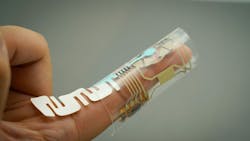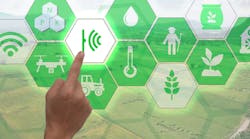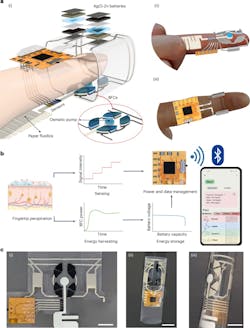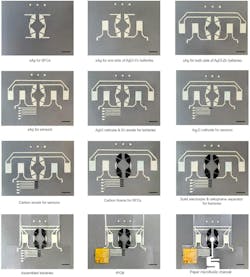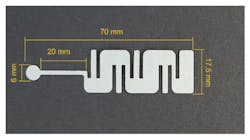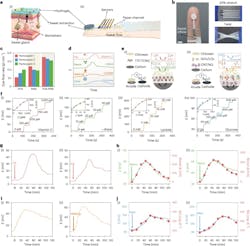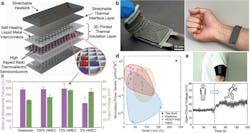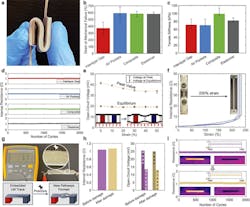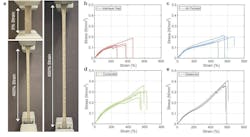"Skin is In": Non-Invasive Biosensing and Energy Harvesting
What you’ll learn:
- Why skin-based sensing and energy harvesting is an attractive research topic.
- How a device harvests power, while also assessing and reporting on biomarker data.
- How a very flexible, puncture- and abuse-tolerant thermoelectric device for harvesting was designed and optimized.
Using a person’s skin for non-invasive bio-data sensing as well as energy harvesting makes sense: It’s available, accessible, risk-free, and likely to receive lots of attention (which leads to future grants). Even if the project isn’t revolutionary or a breakthrough—and let’s face it, they rarely are—innovative aspects still could be further exploited or leveraged. Two recent examples clearly show this situation.
Fingertip Biofuel Cells: Simultaneous Biomarker Assessment and Energy Harvesting
Engineers at the Department of Chemical and Nano Engineering at the University of California, San Diego have developed an electronic finger wrap that monitors vital chemical levels—such as glucose, vitamin C, lactate, and levodopa, a drug used for treating Parkinson’s disease—present in the same fingertip sweat from which it derives its energy (the device can be customized to detect different sets of biomarkers).
Their design uses a single wrap for two functions: bio-assessment and energy harvesting, both based on fingertip sweat. The researchers noted that fingertips are among the body’s most prolific sweat producers, each packed with over a thousand sweat glands and can reliably produce 100X to 1,000X more sweat than most other areas of the body, even during rest.
This constant trickle of natural perspiration—without any stimuli or physical activity—offers a reliable energy source, fueling the device even during periods of inactivity or sleep (Fig. 1).
The bio-based fuel cells were engineered to efficiently collect and convert chemicals in sweat into electricity, which is stored in a pair of stretchable, silver chloride-zinc (AgCl-Zn) batteries. The entire package is fabricated using a layer-by-layer printing process (Fig. 2).
For the sensing function, sweat is wicked through a microgrid based on tiny paper microfluidic channels to enzymatic biofuel cells, where the device analyzes the biomarker levels (Fig. 3). Finally, a small chip processes signals from the sensors and wirelessly transmits the data via Bluetooth Low Energy to a custom-designed smartphone or laptop application.
They performed tests under a variety of operating conditions with associated biomarker results (Fig. 4).
The work is detailed in their Nature Electronics paper “A fingertip-wearable microgrid system for autonomous energy management and metabolic monitoring.” In addition, a supplement provides fabrication and test details along with 42 figures, including a complete schematic diagram of the circuit, PCB photos, and more.
Skin-Heat Harvesting: Designing Stretchable Thermoelectric Devices
Harvesting of skin/ambient temperature differential isn’t a new development—it’s been done with various thermoelectric-generator materials and construction specifics. Now, a team based at the University of Washington has developed a skin-based thermoelectric device (TED) that’s notable for its high levels of flexibility, stretchability, and puncture tolerance.
Their TED has three main layers. At the center are rigid thermoelectric semiconductors that convert heat to electricity. These semiconductors are surrounded by 3D-printed composites with low thermal conductivity, which enhances energy conversion and reduces the device’s weight.
To provide stretchability, conductivity, and electrical self-healing, the semiconductors are connected via printed liquid-metal traces. In addition, liquid-metal droplets are embedded in the outer layers to improve heat transfer to the semiconductors and maintain flexibility because the metal remains liquid at room temperature (Fig. 5). Except for the semiconductors, everything was designed and developed as part of this project.
These TEDs are extremely stretchable, functioning at strain levels as high as 230%. Their unique design, verified through multiphysics simulations and actual tests, results in a fairly high power density of 115.4 μW/cm2 at a low temperature gradient of 10°C. The project involved both simulated and real-sample tests of the effect of different material combinations as well as “infill” ratios on thermoelectric energy conversion and structural integrity.
This was achieved by 3D printing multifunctional elastomers and examining the effects of three thermal insulation infill ratios (0%, 12%, and 100%). The engineered structure is lighter and effectively maintains the temperature gradient across the thermoelectric semiconductors, thereby resulting in higher output voltage and improved heating and cooling performance (Fig. 6).
Furthermore, these thermoelectric generators showed remarkable damage tolerance, remaining fully functional even after multiple punctures and 2,000 stretching cycles at 50% strain. These factors were evaluated using a universal load frame to obtain the stress-strain data, under ASTM D638-14 Standard Test Method (Fig. 7).
The project and the many variations they investigated as simulation, and with real samples, is presented in their paper “3D Soft Architectures for Stretchable Thermoelectric Wearables with Electrical Self-Healing and Damage Tolerance” published in Advanced Materials. A 14-page Supporting Information file provides details on fabrication, variations, test arrangements, and resultant data.
About the Author

Bill Schweber
Contributing Editor
Bill Schweber is an electronics engineer who has written three textbooks on electronic communications systems, as well as hundreds of technical articles, opinion columns, and product features. In past roles, he worked as a technical website manager for multiple topic-specific sites for EE Times, as well as both the Executive Editor and Analog Editor at EDN.
At Analog Devices Inc., Bill was in marketing communications (public relations). As a result, he has been on both sides of the technical PR function, presenting company products, stories, and messages to the media and also as the recipient of these.
Prior to the MarCom role at Analog, Bill was associate editor of their respected technical journal and worked in their product marketing and applications engineering groups. Before those roles, he was at Instron Corp., doing hands-on analog- and power-circuit design and systems integration for materials-testing machine controls.
Bill has an MSEE (Univ. of Mass) and BSEE (Columbia Univ.), is a Registered Professional Engineer, and holds an Advanced Class amateur radio license. He has also planned, written, and presented online courses on a variety of engineering topics, including MOSFET basics, ADC selection, and driving LEDs.
